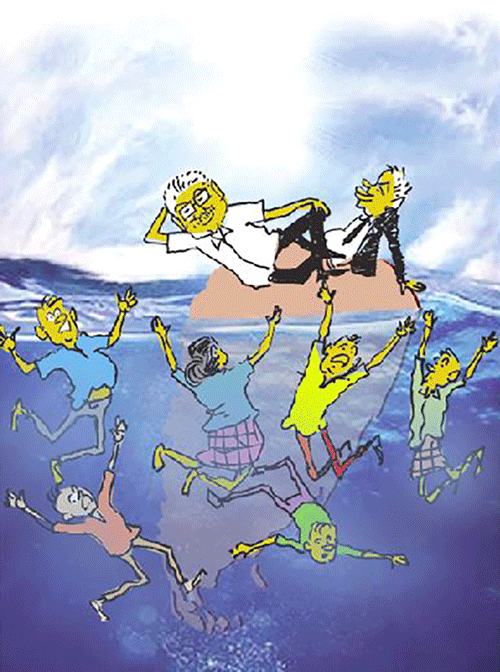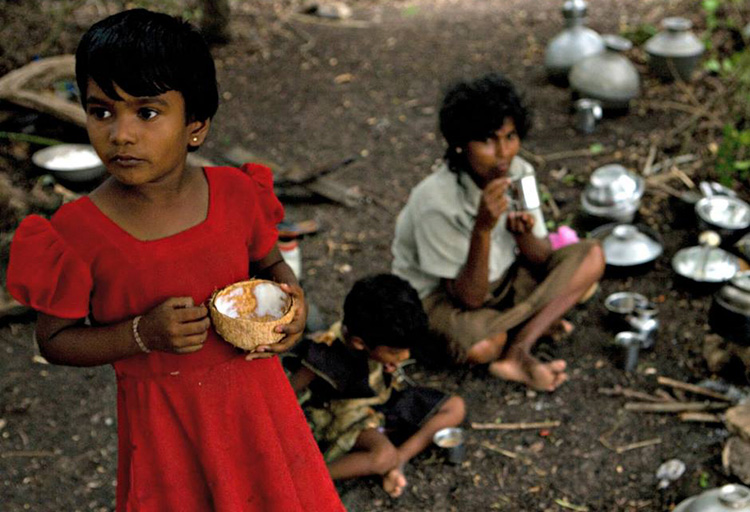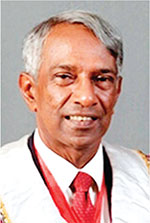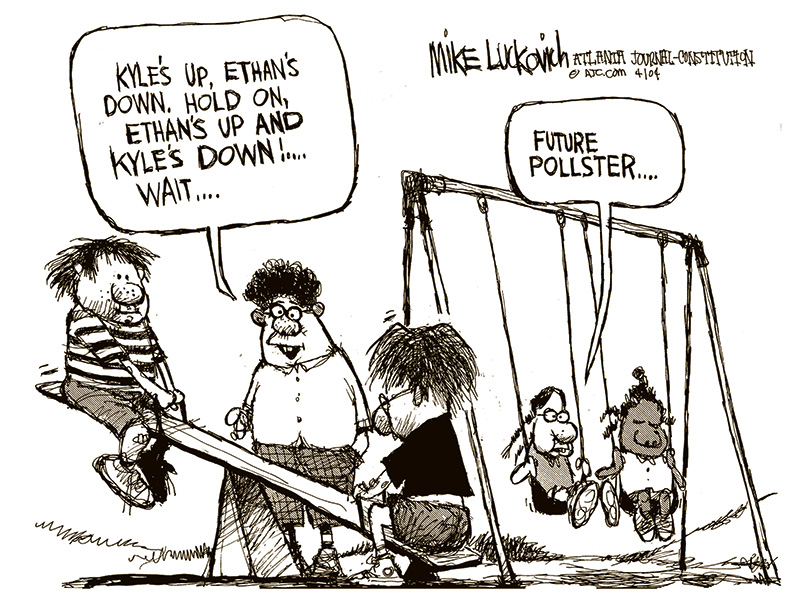Opinion
Crisis deepens without rescue plan

By Dr Laksiri Fernando
Sri Lanka has come to a decisive political-economic juncture with a big question mark on the present administration. Crisis deepens day by day without any plan for its rescue. It appears that the foreign debt default in April this year has affected the local debt market as well. The defaulted foreign debt is not small. While the country owed $7 billion to foreign buyers this year, the total debt is estimated to be over $50 billion. Proper accounts are not kept on this matter. Different figures are given on different occasions.
On 22 June, the government tried to sell Treasury Bills to the value of Rs. 93,000 million but could sell only Rs. 30,779 million, nearly one third. The credibility of debt resettlement is doubted both externally and internally. Out of Rs 30,779 Treasury Bills the bulk and nearly Rs. 20,000 million must be settled in three months. These are the steps of current management, not so different to the previous one.
IMF and All
IMF officials are now in Colombo asking the government to show a viable macroeconomic plan, among other conditions, before they lend dollars, as Sri Lanka had not heeded these requests several times before. They will assist Sri Lanka to restructure debt, while giving the requested 3 billion in stages. Sri Lanka should have requested a bigger amount as the present foreign exchange crisis is insurmountable.
Amnesty International also has sent a letter to the IMF, emphasizing the unfortunate situation of the ‘poor and the vulnerable,’ among other human rights issues. Sri Lanka has a bad record of assisting political supporters and not necessarily the ‘poor and the vulnerable.’ It is also well known that the debt accumulated through sovereign bonds were largely used for unproductive purposes and to the benefit of certain sections. This was largely the same when Ranil Wickremasinghe was running the previous government (2015-2019). Among other things, Amnesty International has said the following:
“To ensure that the verbal commitments above translate into real and effective protections in these difficult times, human rights must be central to any future economic reform programm, negotiated between the IMF and the Sri Lankan government.”
There are several foreign countries who are willing to assist Sri Lanka within the IMF framework, and Australia has already pledged A$ 50 million. The US has announced $12 million assistance (USAID) and this amount might increase. Britain is another country promising support. Japan has been a traditional donor and a lender who has today become somewhat distant. China will continue to assist.
Since January 2022, India has been generously assisting Sri Lanka through currency swaps, credit lines for essentials, and loan deferments. It is estimated that this generosity now amounts to $4 billion. This is mostly a new debt. This has taken a new dilemma because of the controversy over the Adani deal.
No country or international agency would give dollars to Sri Lanka without any condition or some benefit in return. More pertinent question is whether the present Sri Lankan authorities would be able to manage this assistance properly and prudently. There are undoubtedly prospects in resolving the crisis in Sri Lanka. However, do we have the right administration to do so?
Grievances of People
Not only people’s grievances but also anger is visible in various queues for petrol, diesel, kerosene, and cooking gas. Over 10 people have already died almost all of them due to ill health while in these queues overnight. Now there are food queues, mostly women are forced to attend. Most alarming is the shortages of medicine and medical equipment. The death toll is not properly counted. Inflation is now nearly 50% and the poor are the most affected.
Without fuel for their vehicles, people cannot go for work or run their businesses. Public transport is also not working properly due to fuel shortages. Now the government decision is to limit the working week to four days. Is that a right decision is a question? In addition to all these, there have been power cuts due to the lack of necessary fuel to run some power stations. Reuters and others have reported some of the heart rending stories about queues. The following is one:
‘Lasanda Deepthi, a 43-year-old Sri Lankan woman, plans her day around fuel queues. The driver of an auto-rickshaw on the outskirts of the commercial capital Colombo, she keeps a close eye on the petrol gauge of her sky-blue three-wheeler before accepting a job to make sure she has enough fuel.’
A woman three-wheel driver is a rare sight in Sri Lanka. However, Deepthi is one who has selected the job to support her family. She has stated ‘I spend more time in line for petrol than doing anything else. Sometimes I join a line about 3 p.m. but only get fuel about 12 hours later.’
The government and the Energy Ministry should have stopped people unnecessarily joining queues by transparently announcing a scheme how they would distribute the limited fuel to the people. Transparency is something the governments are lacking for a long period. There was no point in using the police or the Army to discipline people when they gather in hundreds or thousands. When you Google on the subject, the following are some news items you come across:
‘Long queues outside gas stations,’ ‘Sri Lanka troops open fire to contain unrest over fuel shortages,’ ‘Clash at fuel queue in Vavuniya – five hospitalized,’ ‘Sri Lanka sees signs of fuel riots as motorists wait for days in queues,’ ‘Clashes reported at gas queues in Kandy.’ ‘Sri Lanka’s poor queue for hours to buy kerosene amid crises,’ ‘Sri Lanka deploys troops as fuel shortages sparks protests,’ ‘Queue for death: Systemic examination of Sri Lankans’, etc.
Roots of Crisis
The crisis that Sri Lanka has been encountering at present is two-fold. (1) Economy is in shambles and the PM himself has named the country as bankrupt. (2) There is an emerging strong opposition, mostly extra-parliamentary, from the youth. It is difficult to distinguish one from the other and that is why it should be called a ‘political-economic’ crisis. If the major problems are not addressed soon, there is a possibility of an ‘uprising.’
The crisis has its roots in decision-making or more correctly erroneous decision-making. That is why people ask particularly the President to resign. Prof Mick Moore (University of Sussex) has uncovered the crisis as ‘manmade.’ Who is the remaining man? Apart from a necessary change of heads, there is a need for a policy change. Some can be outlined below.
Without going or listening to the IMF, the country depended mainly on China and sovereign bonds dubiously sold to questionable foreign institutions and speculators. Amounts were unbearable to the country. There is a possibility that some of the decision-making Sri Lankans had stakes in these institutions when sovereign bonds were sold. Now there is a lawsuit by the dubious Hamilton Reserve Bank against the country for not paying of their sovereign bonds. A former Central Bank Governor is also implicated. Even if they had a clean record, the borrowed money was not used for productive and priority purposes of development. This applies to both China loans and sovereign bonds. These deals should have been transparent.
What was particularly missing was proper financial management in the case of balance of payments and internal budget balances. Most of the budget figures presented were just bogus. Country’s income and expenditure did not match and 2019 budget was a mere disaster. There was no proper transparency. There should be a parliamentary committee, like COPE, to scrutinize past budgets. Or the present COPE should handle it. Lessons can be drawn, or the culprits could be reprimanded. There were huge budget deficits in actual sense and money printing was used as a solution. Local debt also was accumulating throughout the years and as we have noted at the beginning the last Treasury Bill auctions was a disaster.
During 2018, foreign exchange reserves were estimated to be over $9 billion. It came down to $7.6 billion in 2019. This was before the Covid pandemic and with a clear early warning for the policy-makers. However, in the absence of proper measures, the amount came down to $5 billion by the end of 2020. These early warnings were clear enough to go before the IMF. Within the SLPP government and in the country in general there are sections who are opposed to the IMF claiming that the institution is not supportive of developing countries. Even if the IMF was ‘dubious’ during the early period, things have changed over decades. Sri Lanka joined the IMF in 1950. It is one of the important multilateral organisations among other institutions. It is up to the local officials to bargain and deal properly with the IMF.
It is very clear that Sri Lanka had enough time and opportunity to deal with the crisis earlier on. However, this was not done. It is difficult to excuse the President, Gotabaya Rajapaksa, on this matter among other things. He has a pathetic human rights record. Since the beginning of the financial crisis, the authorities have not taken measures properly to mitigate the situation. The ad hoc nature of measures is still a liability and would boomerang on the country again and again.
Opinion
Child food poverty: A prowling menace

 by Dr B.J.C.Perera
by Dr B.J.C.Perera
MBBS(Cey), DCH(Cey), DCH(Eng), MD(Paed), MRCP(UK), FRCP(Edin),
FRCP(Lon), FRCPCH(UK), FSLCPaed, FCCP, Hony FRCPCH(UK), Hony. FCGP(SL)
Specialist Consultant Paediatrician and Honorary Senior Fellow,
Postgraduate Institute of Medicine, University of Colombo, Sri Lanka.
Joint Editor, Sri Lanka Journal of Child Health
In an age of unprecedented global development, technological advancements, universal connectivity, and improvements in living standards in many areas of the world, it is a very dark irony that child food poverty remains a pressing issue. UNICEF defines child food poverty as children’s inability to access and consume a nutritious and diverse diet in early childhood. Despite the planet Earth’s undisputed capacity to produce enough food to nourish everyone, millions of children still go hungry each day. We desperately need to explore the multifaceted deleterious effects of child food poverty, on physical health, cognitive development, emotional well-being, and societal impacts and then try to formulate a road map to alleviate its deleterious effects.
Every day, right across the world, millions of parents and families are struggling to provide nutritious and diverse foods that young children desperately need to reach their full potential. Growing inequities, conflict, and climate crises, combined with rising food prices, the overabundance of unhealthy foods, harmful food marketing strategies and poor child-feeding practices, are condemning millions of children to child food poverty.
In a communique dated 06th June 2024, UNICEF reports that globally, 1 in 4 children; approximately 181 million under the age of five, live in severe child food poverty, defined as consuming at most, two of eight food groups in early childhood. These children are up to 50 per cent more likely to suffer from life-threatening malnutrition. Child Food Poverty: Nutrition Deprivation in Early Childhood – the third issue of UNICEF’s flagship Child Nutrition Report – highlights that millions of young children are unable to access and consume the nutritious and diverse diets that are essential for their growth and development in early childhood and beyond.
It is highlighted in the report that four out of five children experiencing severe child food poverty are fed only breastmilk or just some other milk and/or a starchy staple, such as maize, rice or wheat. Less than 10 per cent of these children are fed fruits and vegetables and less than 5 per cent are fed nutrient-dense foods such as eggs, fish, poultry, or meat. These are horrendous statistics that should pull at the heartstrings of the discerning populace of this world.
The report also identifies the drivers of child food poverty. Strikingly, though 46 per cent of all cases of severe child food poverty are among poor households where income poverty is likely to be a major driver, 54 per cent live in relatively wealthier households, among whom poor food environments and feeding practices are the main drivers of food poverty in early childhood.
One of the most immediate and visible effects of child food poverty is its detrimental impact on physical health. Malnutrition, which can result from both insufficient calorie intake and lack of essential nutrients, is a prevalent consequence. Chronic undernourishment during formative years leads to stunted growth, weakened immune systems, and increased susceptibility to infections and diseases. Children who do not receive adequate nutrition are more likely to suffer from conditions such as anaemia, rickets, and developmental delays.
Moreover, the lack of proper nutrition can have long-term health consequences. Malnourished children are at a higher risk of developing chronic illnesses such as heart disease, diabetes, and obesity later in life. The paradox of child food poverty is that it can lead to both undernutrition and overnutrition, with children in food-insecure households often consuming calorie-dense but nutrient-poor foods due to economic constraints. This dietary pattern increases the risk of obesity, creating a vicious cycle of poor health outcomes.
The impacts of child food poverty extend beyond physical health, severely affecting cognitive development and educational attainment. Adequate nutrition is crucial for brain development, particularly in the early years of life. Malnutrition can impair cognitive functions such as attention, memory, and problem-solving skills. Studies have consistently shown that malnourished children perform worse academically compared to their well-nourished peers. Inadequate nutrition during early childhood can lead to reduced school readiness and lower IQ scores. These children often struggle to concentrate in school, miss more days due to illness, and have lower overall academic performance. This educational disadvantage perpetuates the cycle of poverty, as lower educational attainment reduces future employment opportunities and earning potential.
The emotional and psychological effects of child food poverty are profound and are often overlooked. Food insecurity creates a constant state of stress and anxiety for both children and their families. The uncertainty of not knowing when or where the next meal will come from can lead to feelings of helplessness and despair. Children in food-insecure households are more likely to experience behavioural problems, including hyperactivity, aggression, and withdrawal. The stigma associated with poverty and hunger can further exacerbate these emotional challenges. Children who experience food poverty may feel shame and embarrassment, leading to social isolation and reduced self-esteem. This psychological toll can have lasting effects, contributing to mental health issues such as depression and anxiety in adolescence and adulthood.
Child food poverty also perpetuates cycles of poverty and inequality. Children who grow up in food-insecure households are more likely to remain in poverty as adults, continuing the intergenerational transmission of disadvantage. This cycle of poverty exacerbates social disparities, contributing to increased crime rates, reduced social cohesion, and greater reliance on social welfare programmes. The repercussions of child food poverty ripple through society, creating economic and social challenges that affect everyone. The healthcare costs associated with treating malnutrition-related illnesses and chronic diseases are substantial. Additionally, the educational deficits linked to child food poverty result in a less skilled workforce, which hampers economic growth and productivity.
Addressing child food poverty requires a multi-faceted approach that tackles both immediate needs and underlying causes. Policy interventions are crucial in ensuring that all children have access to adequate nutrition. This can include expanding social safety nets, such as food assistance programmes and school meal initiatives, as well as targeted manoeuvres to reach more vulnerable families. Ensuring that these programmes are adequately funded and effectively implemented is essential for their success.
In addition to direct food assistance, broader economic and social policies are needed to address the root causes of poverty. This includes efforts to increase household incomes through living wage policies, job training programs, and economic development initiatives. Supporting families with affordable childcare, healthcare, and housing can also alleviate some of the financial pressures that contribute to food insecurity.
Community-based initiatives play a vital role in combating child food poverty. Local food banks, community gardens, and nutrition education programmes can help provide immediate relief and promote long-term food security. Collaborative efforts between government, non-profits, and the private sector are necessary to create sustainable solutions.
Child food poverty is a profound and inescapable issue with far-reaching consequences. Its deleterious effects on physical health, cognitive development, emotional well-being, and societal stability underscore the urgent need for comprehensive action. As we strive for a more equitable and just world, addressing child food poverty must be a priority. By ensuring that all children have access to adequate nutrition, we can lay the foundation for a healthier, more prosperous future for individuals and society as a whole. The fight against child food poverty is not just a moral imperative but an investment in our collective future. Healthy, well-nourished children are more likely to grow into productive, contributing members of society. The benefits of addressing this issue extend beyond individual well-being, enhancing economic stability and social harmony. It is incumbent upon us all to recognize and act upon the understanding that every child deserves the right to adequate nutrition and the opportunity to thrive.
Despite all of these existent challenges, it is very definitely possible to end child food poverty. The world needs targeted interventions to transform food, health, and social protection systems, and also take steps to strengthen data systems to track progress in reducing child food poverty. All these manoeuvres must comprise a concerted effort towards making nutritious and diverse diets accessible and affordable to all. We need to call for child food poverty reduction to be recognized as a metric of success towards achieving global and national nutrition and development goals.
Material from UNICEF reports and AI assistance are acknowledged.
Opinion
Do opinion polls matter?

By Dr Upul Wijayawardhana
The colossal failure of not a single opinion poll predicting accurately the result of the Indian parliamentary election, the greatest exercise in democracy in the world, raises the question whether the importance of opinion polls is vastly exaggerated. During elections two types of opinion polls are conducted; one based on intentions to vote, published during or before the campaign, often being not very accurate as these are subject to many variables but exit polls, done after the voting where a sample tally of how the voters actually voted, are mostly accurate. However, of the 15 exit polls published soon after all the votes were cast in the massive Indian election, 13 vastly overpredicted the number of seats Modi’s BJP led coalition NDA would obtain, some giving a figure as high as 400, the number Modi claimed he is aiming for. The other two polls grossly underestimated predicting a hung parliament. The actual result is that NDA passed the threshold of 272 comfortably, there being no landslide. BJP by itself was not able to cross the threshold, a significant setback for an overconfident Mody! Whether this would result in less excesses on the part of Modi, like Muslim-bashing, remains to be seen. Anyway, the statement issued by BJP that they would be investigating the reasons for failure rather than blaming the process speaks very highly of the maturity of the democratic process in India.
I was intrigued by this failure of opinion polls as this differs dramatically from opinion polls in the UK. I never failed to watch ‘Election night specials’ on BBC; as the Big Ben strikes ‘ten’ (In the UK polls close at 10pm} the anchor comes out with “Exit polls predict that …” and the actual outcome is often almost as predicted. However, many a time opinion polls conducted during the campaign have got the predictions wrong. There are many explanations for this.
An opinion poll is defined as a research survey of public opinion from a particular sample, the origin of which can be traced back to the 1824 US presidential election, when two local newspapers in North Carolina and Delaware predicted the victory of Andrew Jackson but the sample was local. First national survey was done in 1916 by the magazine, Literary Digest, partly for circulation-raising, by mailing millions of postcards and counting the returns. Of course, this was not very scientific though it accurately predicted the election of Woodrow Wilson.
Since then, opinion polls have grown in extent and complexity with scientific methodology improving the outcome of predictions not only in elections but also in market research. As a result, some of these organisations have become big businesses. For instance, YouGov, an internet-based organisation co-founded by the Iraqi-born British politician Nadim Zahawi, based in London had a revenue of 258 million GBP in 2023.
In Sri Lanka, opinion polls seem to be conducted by only one organisation which, by itself, is a disadvantage, as pooled data from surveys conducted by many are more likely to reflect the true situation. Irrespective of the degree of accuracy, politicians seem to be dependent on the available data which lend explanations to the behaviour of some.
The Institute for Health Policy’s (IHP) Sri Lanka Opinion Tracker Survey has been tracking the voting intentions for the likely candidates for the Presidential election. At one stage the NPP/JVP leader AKD was getting a figure over 50%. This together with some degree of international acceptance made the JVP behave as if they are already in power, leading to some incidents where their true colour was showing.
The comments made by a prominent member of the JVP who claimed that the JVP killed only the riff-raff, raised many questions, in addition to being a total insult to many innocents killed by them including my uncle. Do they have the authority to do so? Do extra-judicial killings continue to be JVP policy? Do they consider anyone who disagrees with them riff-raff? Will they kill them simply because they do not comply like one of my admired teachers, Dr Gladys Jayawardena who was considered riff-raff because she, as the Chairman of the State Pharmaceutical Corporation, arranged to buy drugs cheaper from India? Is it not the height of hypocrisy that AKD is now boasting of his ties to India?
Another big-wig comes with the grand idea of devolving law and order to village level. As stated very strongly, in the editorial “Pledges and reality” (The Island, 20 May) is this what they intend to do: Have JVP kangaroo-courts!
Perhaps, as a result of these incidents AKD’s ratings has dropped to 39%, according to the IHP survey done in April, and Sajith Premadasa’s ratings have increased gradually to match that. Whilst they are level pegging Ranil is far behind at 13%. Is this the reason why Ranil is getting his acolytes to propagate the idea that the best for the country is to extend his tenure by a referendum? He forced the postponement of Local Governments elections by refusing to release funds but he cannot do so for the presidential election for constitutional reasons. He is now looking for loopholes. Has he considered the distinct possibility that the referendum to extend the life of the presidency and the parliament if lost, would double the expenditure?
Unfortunately, this has been an exercise in futility and it would not be surprising if the next survey shows Ranil’s chances dropping even further! Perhaps, the best option available to Ranil is to retire gracefully, taking credit for steadying the economy and saving the country from an anarchic invasion of the parliament, rather than to leave politics in disgrace by coming third in the presidential election. Unless, of course, he is convinced that opinion polls do not matter and what matters is the ballots in the box!
Opinion
Thoughtfulness or mindfulness?

By Prof. Kirthi Tennakone
ktenna@yahoo.co.uk
Thoughtfulness is the quality of being conscious of issues that arise and considering action while seeking explanations. It facilitates finding solutions to problems and judging experiences.
Almost all human accomplishments are consequences of thoughtfulness.
Can you perform day-to-day work efficiently and effectively without being thoughtful? Obviously, no. Are there any major advancements attained without thought and contemplation? Not a single example!
Science and technology, art, music and literary compositions and religion stand conspicuously as products of thought.
Thought could have sinister motives and the only way to eliminate them is through thought itself. Thought could distinguish right from wrong.
Empathy, love, amusement, and expression of sorrow are reflections of thought.
Thought relieves worries by understanding or taking decisive action.
Despite the universal virtue of thoughtfulness, some advocate an idea termed mindfulness, claiming the benefits of nurturing this quality to shape mental wellbeing. The concept is defined as focusing attention to the present moment without judgment. A way of forgetting the worries and calming the mind – a form of meditation. A definition coined in the West to decouple the concept from religion. The attitude could have a temporary advantage as a method of softening negative feelings such as sorrow and anger. However, no man or woman can afford to be non-judgmental all the time. It is incompatible with indispensable thoughtfulness! What is the advantage of diverting attention to one thing without discernment during a few tens of minute’s meditation? The instructors of mindfulness meditation tell you to focus attention on trivial things. Whereas in thoughtfulness, you concentrate the mind on challenging issues. Sometimes arriving at groundbreaking scientific discoveries, solution of mathematical problems or the creation of masterpieces in engineering, art, or literature.
The concept of meditation and mindfulness originated in ancient India around 1000 BCE. Vedic ascetics believed the practice would lead to supernatural powers enabling disclosure of the truth. Failing to meet the said aspiration, notwithstanding so many stories in scripture, is discernable. Otherwise, the world would have been awakened to advancement by ancient Indians before the Greeks. The latter culture emphasized thoughtfulness!
In India, Buddha was the first to deviate from the Vedic philosophy. His teachers, Alara Kalama and Uddaka Ramaputra, were adherents of meditation. Unconvinced of their approach, Buddha concluded a thoughtful analysis of the actualities of life should be the path to realisation. However, in an environment dominated by Vedic tradition, meditation residually persisted when Buddha’s teachings transformed into a religion.
In the early 1970s, a few in the West picked up meditation and mindfulness. We Easterners, who criticize Western ideas all the time, got exalted after seeing something Eastern accepted in the Western circles. Thereafter, Easterners took up the subject more seriously, in the spirit of its definition in the West.
Today, mindfulness has become a marketable commodity – a thriving business spreading worldwide, fueled largely by advertising. There are practice centres, lessons onsite and online, and apps for purchase. Articles written by gurus of the field appear on the web.
What attracts people to mindfulness programmes? Many assume them being stressed and depressed needs to improve their mental capacity. In most instances, these are minor complaints and for understandable reasons, they do not seek mainstream medical interventions but go for exaggeratedly advertised alternatives. Mainstream medical treatments are based on rigorous science and spell out both the pros and cons of the procedure, avoiding overstatement. Whereas the alternative sector makes unsubstantiated claims about the efficacy and effectiveness of the treatment.
Advocates of mindfulness claim the benefits of their prescriptions have been proven scientifically. There are reports (mostly in open-access journals which charge a fee for publication) indicating that authors have found positive aspects of mindfulness or identified reasons correlating the efficacy of such activities. However, they rarely meet standards normally required for unequivocal acceptance. The gold standard of scientific scrutiny is the statistically significant reproducibility of claims.
If a mindfulness guru claims his prescription of meditation cures hypertension, he must record the blood pressure of participants before and after completion of the activity and show the blood pressure of a large percentage has stably dropped and repeat the experiment with different clients. He must also conduct sessions where he adopts another prescription (a placebo) under the same conditions and compares the results. This is not enough, he must request someone else to conduct sessions following his prescription, to rule out the influence of the personality of the instructor.
The laity unaware of the above rigid requirements, accede to purported claims of mindfulness proponents.
A few years ago, an article published and widely cited stated that the practice of mindfulness increases the gray matter density of the brain. A more recent study found there is no such correlation. Popular expositions on the subject do not refer to the latter report. Most mindfulness research published seems to have been conducted intending to prove the benefits of the practice. The hard science demands doing the opposite as well-experiments carried out intending to disprove the claims. You need to be skeptical until things are firmly established.
Despite many efforts diverted to disprove Einstein’s General Theory of Relativity, no contradictions have been found in vain to date, strengthening the validity of the theory. Regarding mindfulness, as it stands, benefits can neither be proved nor disproved, to the gold standard of scientific scrutiny.
Some schools in foreign lands have accommodated mindfulness training programs hoping to develop the mental facility of students and Sri Lanka plans to follow. However, studies also reveal these exercises are ineffective or do more harm than good. Have we investigated this issue before imitation?
Should we force our children to focus attention on one single goal without judgment, even for a moment?
Why not allow young minds to roam wild in their deepest imagination and build castles in the air and encourage them to turn these fantasies into realities by nurturing their thoughtfulness?
Be more thoughtful than mindful?












